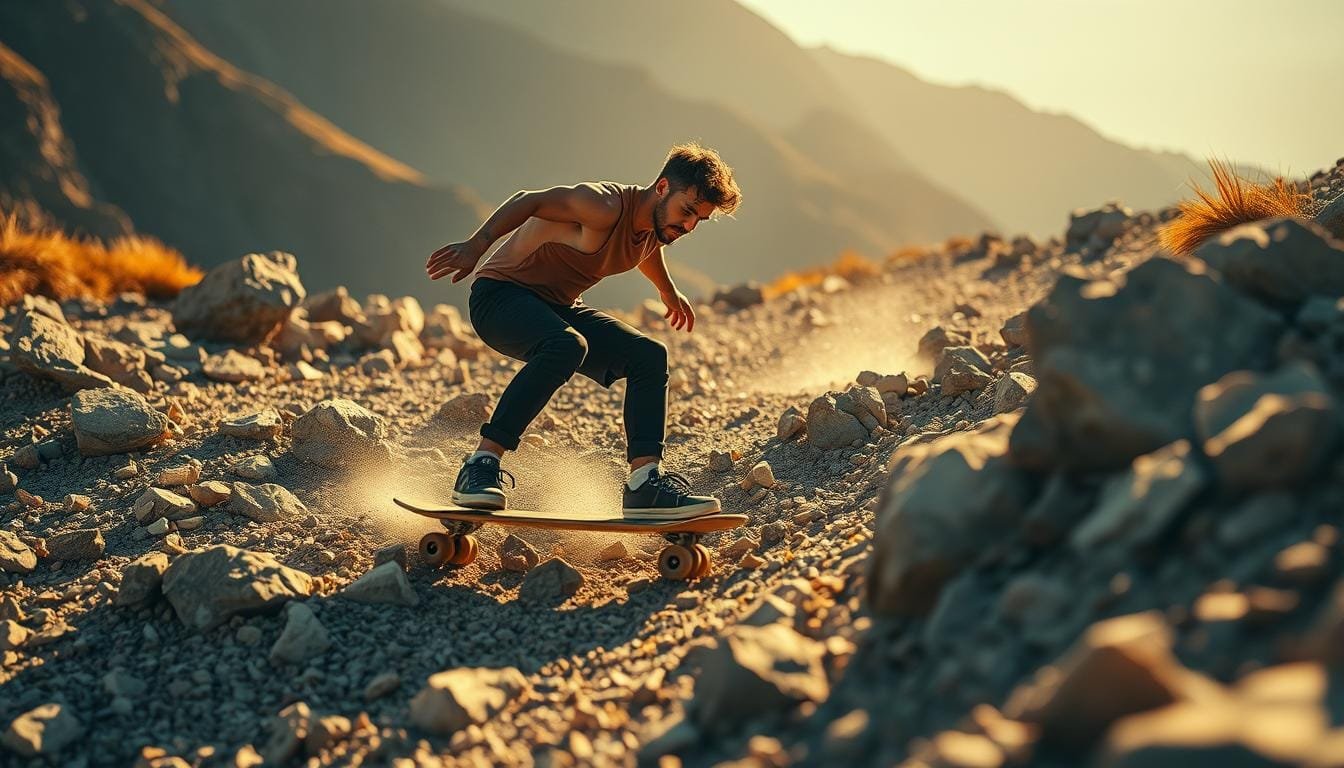Skateboarding on rough terrain is a different game. It’s not like gliding on smooth asphalt. Bumpy roads challenge your skills and make you more aware of risks.
Skating on uneven surfaces can be risky. It can harm your skateboard and increase the chance of falling. But, with the right techniques and safety gear, you can conquer these challenges. This guide will teach you how to handle rough skateboarding environments.
Key Takeaways
- Understand the challenges and risks associated with skateboarding on rough surfaces.
- Know the importance of choosing the right skateboard for rough terrain.
- Learn techniques to navigate bumpy roads effectively.
- Recognize the critical role of wearing appropriate safety gear.
- Practice regularly to improve your rough terrain skateboarding skills.
Understanding Rough Terrain and Its Challenges
Skateboarding on bumpy surfaces introduces tough skateboarding challenges. You need more skills and focus on uneven, cracked, or debris-filled paths. To skate well on rough surfaces, you must learn advanced moves and have the right gear for safety and fun.
Keeping your balance on uneven paths is key. You’ll need to constantly adjust, which can make your legs tired quickly. That highlights the need for strong legs and stamina. Moves like ollies, big carves, and pumping are vital. They help you handle different grounds like gravel, grass, and dirt.
The way a surface feels changes how you skate on it. Skateboarding on asphalt is smoother but can make your gear wear out faster. It’s crucial to prevent wheel bite, which happens when wheels hit the skateboard deck on tight turns. This can make you stop suddenly and is a known problem on rough surfaces.
Starting slow helps you avoid dangers. Beginning with a gentle speed lets you get comfortable and in control on tougher grounds. Using softer wheels that are made of rubber can also help. They give you better grip and smooth out the ride on uneven areas.
Research shows that skating on different kinds of grounds speeds up skill learning by 50%. Downhill skating, where speeds can go over 30 mph, highlights the need to know how to slide. This helps control your speed and prevent crashes. Plus, safety gear can lessen injury risks by up to 70%. This shows that it’s vital for skating on bumpy grounds.
It’s super important to wear a full-face helmet in downhill skating. It can cut down the chance of bad head injuries by up to 90%. Also, mastering basic slides like the Coleman and pendulum can help you manage better. Skaters have a 70% better chance of success with these slides when they practice them often.
Knowing what’s around you is very important. Many skating accidents happen because of surprises on the road. Always check your skateboard for damage after riding on rough paths. This keeps you safe and your board in good shape.
Skateboarding takes a lot of practice. Stats show that 80% of skateboarders get way better after six months of regular practice. To enjoy and do well in skating on rough terrain, using the correct technique, being aware, and having the right equipment are key.
Choosing the Right Skateboard for Rough Terrain
When picking the best skateboards for rough terrain, every detail counts. Look for a tough deck made of Canadian maple or carbon fiber. This makes sure the skateboard lasts in tough spots. Decks should be 30 to 40 inches long and 7.5 to 10 inches wide for the best stability.
Wheels matter a lot in your skateboard selection guide. Soft wheels, with ratings from 78A to 87A, are better for rough grounds. They offer good grip and soften bumps. Bigger wheels, around 100mm to 120mm, also add control and keep things stable.
The wheel’s tread pattern is key for performance. For dirt and gravel, go for deeper and wider treads. If you’re on solid ground, shallower patterns work best. The right tread improves grip, making tough terrain easier to handle.
Consider small, important parts like top-notch bearings. They affect how smooth and fast you skate. Brakes are crucial too. Hand brakes give more control going downhill than foot brakes. They’re especially handy on tricky terrain.
Last of all, think about the environment when choosing your gear. Durable, earth-friendly materials are good for the planet and your skating. They don’t sacrifice performance or lasting power.
Techniques for Navigating Rough Terrain
Learning how to skateboard on bumpy paths is key for safe and fun rides. It’s important to adjust your stance and how you spread your weight. Leaning a bit forward helps you keep balance and control on uneven ground.
The tic-tac method also works well, especially for gaining speed without much pushing. By moving your weight from side to side, your skateboard can roll smoothly over bumps. Plus, being able to lift the front of your skateboard makes it easier to cross over rough spots.
Skateboarding tricks like the ollie help you get past big obstacles. These moves let you lift the skateboard off the ground, so you can keep going fast.
When skating downhill, it’s crucial to control how fast you’re going. The Coleman slide is a good way to slow down safely. Mastering slides not only lets you manage your speed but also helps you turn better on steep hills.
Practice makes perfect in skateboarding. Skating in the city teaches you to be aware of your surroundings, so you can dodge obstacles and people. And don’t forget: wearing helmets, knee pads, and elbow pads is super important for your safety.
Overall, getting good at different skateboarding moves and tricks makes it easier to handle rough spots. Staying focused, practicing a lot, and wearing the right safety gear are all crucial when you’re skating on challenging terrain.
Safety Gear You Shouldn’t Skimp On
Skateboarding on rough ground? High-quality skateboard safety gear is crucial. It’s more than looking good; it’s about your safety. Helmets, knee pads, elbow pads, and wrist guards are key. Pros also suggest padded shorts or armor for extra protection during falls.
Helms are super important. They cut down head and brain injury risks by 65-88%. They also lower the chance of face injuries by 65% and fatal outcomes by 37%. Make sure your helmet meets CPSC 1203 and ASTM F1492 standards. Skateboard helms are built for multiple impacts, offering more head coverage. This is vital for preventing injuries from backward falls.
Being seen is key too. Wear high-visibility clothes to stay safe, especially near traffic or in dim light. Knee and elbow pads also help, preventing fractures and sprains. Half of all skaters get hurt, and pads can protect you.
Despite risks, only 25% of skateboarders regularly wear protective gear for skateboarding. The risk of falling is 40% higher on rough surfaces. This makes quality safety gear a smart investment.
Don’t ignore the little things when picking your gear. Skate helmets have vents to keep out objects while letting air in. Below, see how different gear can reduce injury risks.
| Safety Gear | Risk Reduction |
|---|---|
| Helmet | 65-88% (Head/Brain Injuries) |
| Knee Pads | Reduces Fracture Risk |
| Elbow Pads | Reduces Sprain Risk |
| Wrist Guards | Reduces Wrist Injuries |
Investing in essential skateboarding equipment boosts your confidence and safety. So gear up before tackling those tough terrains.
Practicing and Improving Your Skills
To really get good at handling rough spots, practice a lot. Start slow to get your basics down pat. This way, you build up your confidence and can slowly move on to trickier stuff. When you face bumps and cracks, learn specific tricks. Ollies, carving, and pumping will make you better at controlling your speed.
Try skating on different types of ground, not just concrete. Mixing in gravel, grass, and dirt will make your skills sharper. You’ll learn to adapt your skateboarding to different situations. Also, use the right gear. Soft wheels that are big (70mm to 100mm) can really help on rough ground.
Talking to other skaters can give you some great advice. They can share things you might not figure out by yourself. Make sure your skateboard is always ready to go. Check it often and replace parts that are wearing out. Looking for more tips? Check out this guide.
Getting better isn’t just about the physical part. You need to think positive and set goals you can reach. See yourself nailing those runs in your mind. Keep at it, learn the right way to do things, and find people who cheer you on. You’ll see your skills grow and you’ll nail those rough spots easily.

I’m John Peterson, a passionate skater, blogger, and lifelong enthusiast. I’ve been skating for over 9 years and have gone on to write a blog dedicated to the sport of skating and its culture. Through my blog, I strive to share my knowledge and experience of the sport with all who are interested. From beginner tips, tricks, and equipment reviews to interviews and event coverage, I cover it all. So read my blog as I explore the wonderful world of skating!

